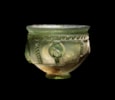Important Glass Bowl
Important Glass Bowl
Merovingian or Gallo-Roman
4th - 5th Century A.D.
Glass
H: 9cm W: 11.8cm
Sold
Gallo-Roman or Merovingian, A pale green glass bowl, with everted lip, standing on a ring-foot. The surface has been separated into four panels, separated by vertical strips decorated by raised horizontal bands; with horizontal borders above and below, the above decorated with a raised zigzag pattern. In the centre of each panel is a hollow-blown claw. An antique label is attached to the base, giving us the date 1849. The present bowl bears great similarity to a number of 4th-5th century A.D. glass bowls that have been found in Northern France, Belgium and Luxembourg, and that are presumed to have been made by the local Gallo-Roman population. One example, in the Metropolitan Museum of Art, New York, was found in the cemetery at Steinfort, Luxembourg and dated 375-425 A.D. This kind of hollow-blown claw decoration was evidently popular with the 5th-century Frankish invaders and subsequent Frankish-Merovingian society, as glass featuring this style of decoration has been found dating up the 8th century. It also inspired the Anglo-Saxons, as glass claw beakers have been found in Anglo-Saxon burials. This bowl was discovered in the mid-19th century in a Gallo-Roman stone sarcophagus unearthed underneath the walls of the Chateau de Montataire, in northern France. Montataire is a well-known Merovingian necropolis, discovered in the 19th century and further excavated in the 20th. The earliest funerary goods found there date to the late 5th century A.D. Scientific studies show that the population of Montataire was predominantly Gallo-Roman, which was Christianised early and shares many similarities with the early Christian Gallo-Roman cemetery of Marteville, Picardie. A similar bowl to the present one was recovered from the grave of a man there, along with a coin with the Emperor Gratian (359-383 A.D.). It is unclear if the tomb where the bowl was found was part of the main necropolis, as it is set a little apart. The other funerary goods recovered from Montataire are quite poor, and this bowl categorically stands out. Other glass vessels are also rare. Given the parallels, it is likely the present bowl was created in a similar context to the Steinfort and Marteville bowls. It is a prime example of the sophisticated glass-blowing technique which was first brought to the area by the Romans and later perfected.
George Ferdinand, Baron de Condé, Histoire d’un vieux chateau de France: Monographie de Chateau Montataire, Paris 1883, pp. 33–35
David Aaron Ltd, 2022, No.20
Discovered in 1849 in a Gallo-Roman sarcophagus by Mr. Minguet in the grounds of Château de Montataire, France(accompanied by an old collection label from 1849).
Subsequently kept at Château de Mello, France (accompanied by a handwritten note in the family’s inventory of 1866).
Likely, François Alexandre, 3rd Baron Seillière (1782-1850), who bought the Château de Mello in 1819.
His son, Florentin-Achille, 4th Baron (1813-1873).
His sons, Raymond (1845-1912) and François-Alexandre, 5th Baron Seillière (1849-1932).
Thence by descent.
ALR: S00214480, with IADAA certificate, this item has ben checked against the Interpol database
This important glass bowl was discovered in a Gallo-Roman stone sarcophagus in 1849 by a Mr. Minguet, who was living in the grounds against the walls of the Château de Montataire in Oise, northern France, at the time, and who unearthed it when digging a new cellar. Upon discovering the sarcophagus, in which lay the glass bowl and a number of other grave goods which are unfortunately not recorded, Mr. Minguet immediately expressed a desire to be buried in it. Sadly, he soon got his will, as he died from cholera not long after. He was indeed buried in the sarcophagus, along with his pipe and his bottle of brandy, although it was apparently a great deal of trouble to get the enormously heavy stone coffin from the castle grounds to the village cemetery. In the end the men of the village had to transport it on a contraption used to haul blocks of stone which was nicknamed 'the devil', causing all the women of the village to cry that it was the devil that had taken him to his grave!
The discovery of this sarcophagus, and Mr. Minguet's untimely death soon after, is recorded by the new owner of the Château de Montataire, Baron George Ferdinand de Condé, in his history of the castle, written in 1883. He records that the bowl was subsequently kept at the Château de Mello, a neighbouring castle not 1 hr 30 mins walk from the Château de Montataire. Château de Mello was at the time of the bowl's discovery owned by the Seillière family, a wealthy banking family who had bought the castle in 1819. The father, François-Alexandre Seillière, died in 1850 and the son Florentin-Achille Seillière (1813-1873) inherited. It is likely that the Baron de Condé, who is recorded as having visited the Château de Montataire as early as 1846 with a view to purchasing it, gave or sold the bowl to his neighbours, who he most likely knew. Florentin-Achille Seillière was a noted art collector, with a particularly famous library. The bowl is mentioned in the Seillière family inventory of the Château de Mello, where it is also later recorded that the exterior vase (there being two, one inside the other) had broken, and the interior remained. This bowl is therefore the smaller, interior glass. The bowl remained in the same family, in the Château de Mello, until very recently.










 Enquire
Enquire




